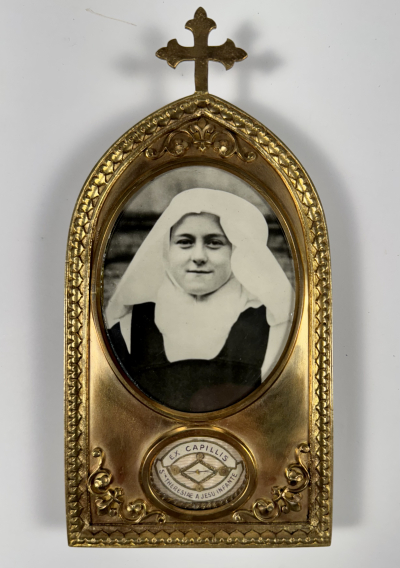Saint Therese de Lisieux OCD († 1897), popularly known as "The Little Flower of Jesus," was a Roman Catholic French Discalced Carmelite nun widely venerated in modern times. After nine years as a Carmelite religious, having fulfilled various offices, and having spent her last eighteen months in Carmel in a night of faith, she died of tuberculosis at the age of 24. Thérèse has been a highly influential model of sanctity for Catholics and for others because of the "simplicity and practicality of her approach to the spiritual life". Together with Saint Francis of Assisi, she is one of the most popular saints in the history of the church. Pope Pius X called her "the greatest saint of modern times". She is a holy patron of Gardens of Vatican City, Missionaries; France; Russia; HIV/AIDS sufferers; radio care-a-thons; florists and gardeners; loss of parents; tuberculosis; and the Russicum; Alaska. Therese was beatified in 1923 and canonized on 17 May 1925 by Pope Pius XI, only 28 years after her death. Her feast day is commemorated on 1 October.
An attractive glass-fronted brass reliquary frame with a first-class relic of Saint Therese de Lisieux. The relics comprised of three short strands of hair are housed in an oval cavity under a photographic portrait of the saint. They are affixed to the ground of silk and identified in Latin on a typeset cedula label as Ex Capillis // St. Theresiae a Jesu Infante (of the hair of St. Therese of Child Jesus). On the back, under a protective cap, the reliquary is secured by a seal of red Spanish wax with an imprint of the coat of arms of the Discalced Carmelite Order. The reliquary come with an original undated and unsigned letter of testimony in the French language stating the following:
"Relic of the Most Holy Therese of the Child Jesus, offered by the Carmel of Metz to Monsignor Heintz, Bishop of Metz. It was venerated in the private chapel of Monsignor Heintz until his return to God in November 1958. Then it was offered to me in June 1962 by Monsignor Schmitt, his successor."
Fr. Joseph-Jean Heintz († 30 Nov 1958) was a Bishop of Metz between 1938 and 1958.
Additional Info
- ID#: 17-RSGA-9
- Size: 18 x 9 cm ( 7 x 3 1/2 inches)
- Age: ca. 1930s
- Origin: Metz, France
- Materials: brass, glass, paper, silk, silver, Spanish wax
- Price: SOLD!
Additional Images of this Item
Online Store & Services
Information
Quick Link
Information
Quick Link
SAVE 5% from your first purchase when you subscribe to receive our infrequent mailings with updates on new arrivals, exclusive offers, and fascinating stories on relevant subjects.








 Поменять язык на русский
Поменять язык на русский 